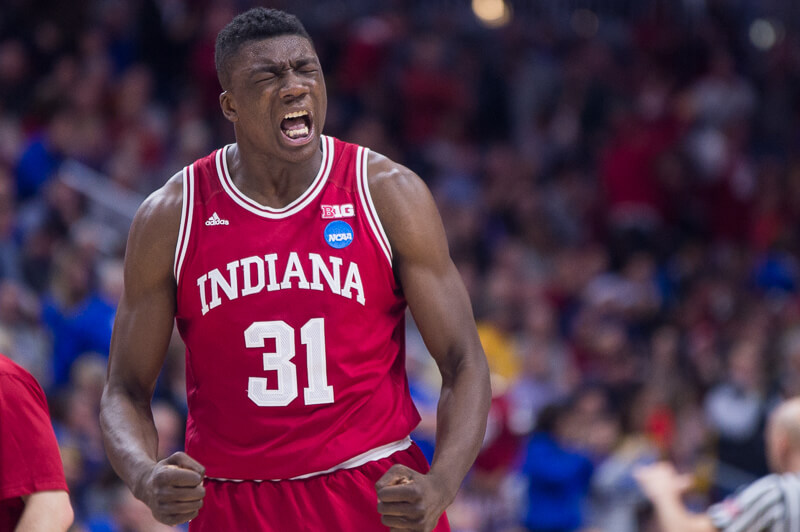The boom began in 2012–13, when 30 up-transfers became eligible, including Luke Hancock, who jumped from George Mason to Louisville, and then was the Most Outstanding Player of the 2013 Final Four. In a column prior to that season, I coined up-transfer to describe a trend that would keep on growing. From ‘12–13 to ‘16–17, the average number of up-transfers becoming eligible is 37.2—a 389% jump from the previous five-year period. In comparison, the overall transfer market has grown by 35–40% between those same five-year periods, according to my estimates based on data from the NCAA and VerbalCommits.com.
Around the Hall: Big Ten coaching stability, Bryant’s return, more

Around the Hall is recommended reading from the Inside the Hall staff.
Over at ESPN Insider ($), Jeff Goodman takes a look at coaching stability for Big Ten coaches. The piece ranks John Groce and Richard Pitino as the two coaches in league on the hottest seats:
It doesn’t look great for Pitino at Minnesota these days. He has a new athletic director in Mark Coyle, is coming off an 8-23 season and has dealt with several off-court issues with his players (some now ex-players). The AD who hired him, Norwood Teague, is gone — as is his right-hand man and former associate AD, Mike Ellis. Pitino, 33, is under contract through 2021, but he can’t go 2-16 in Big Ten play again and expect to keep his job.
Gary Parrish of CBSSports.com talked to Thomas Bryant about his decision to return to Bloomington. It’s a decision that Bryant is still behind 100 percent:
He’s happy doing what he’s doing.
He doesn’t want to do what those summer league guys are doing.
“I’ve never had second thoughts about coming back to school,” Bryant told me by phone. “I knew coming back after my freshman year would be the best decision for me. I just didn’t think I was ready.”
Troy Williams was the best dunker in the NBA Summer League, according to Kevin Pelton of ESPN Insider ($):
At one point after a thunderous putback, I told a colleague that Williams’ nickname was “Helicopter.” This does not appear to be the case, but maybe we should make it so. Williams spent much of his time in Vegas above the rim, at least when he wasn’t hoping to prove to possible NBA suitors that he’s also capable beyond the arc. (Williams shot 26.3 percent on 3-point attempts, but 74.1 percent on 2s, mostly dunks.)
NBCSports.com runs through some of the recent changes the NCAA announced for the tournament selection committee and process:
Per the NCAA, the top overall seed in the NCAA tournament will get to choose where they play the first weekend of the tournament. Teams considered to be in the running for the top overall seed will submit their preferences to the selection committee well in advance of Selection Sunday, so there won’t be any knowledge of possible opponents at that time.
While this is a change to how the NCAA has done things in past brackets, going primarily by mileage when looking to place top seeds as close to their campus as possible, this isn’t exactly a seismic shift since the top overall seed won’t be known until Sunday. But it does give those top teams an option, with designs on it being an additional perk that those programs will have earned.
ESPN.com runs through each preseason top 25 team with a look at which player should take the last shot in a tight game:
11. Indiana Hoosiers: James Blackmon Jr.
One of the most impressive aspects of Indiana’s success last season was that it came with Blackmon, Jr. spending most of the season on the bench because of injury. Blackmon, who has averaged 15.8 points and shot 42.5 percent from 3 in his 46-game career, is a smooth offensive talent, a knockdown shooter who can create his own looks to boot. With Yogi Ferrell gone, expect the ball in Blackmon’s hands early and often in 2016-17.
Cody Zeller is dealing with a sore knee that caused him to miss scrimmaging against the USA National team in Las Vegas this week:
Charlotte Hornets center Cody Zeller had to miss scrimmaging against Team USA this week in Las Vegas due to a sore right knee.
An NBA source confirmed Zeller had some soreness that caused him to cancel his participation with the USA Select Team. The injury is not considered serious.
Luke Winn of SI.com takes a look inside the “up-transferring” boom in college basketball:
Category: Media
Filed to: James Blackmon Jr., Thomas Bryant, Troy Williams
